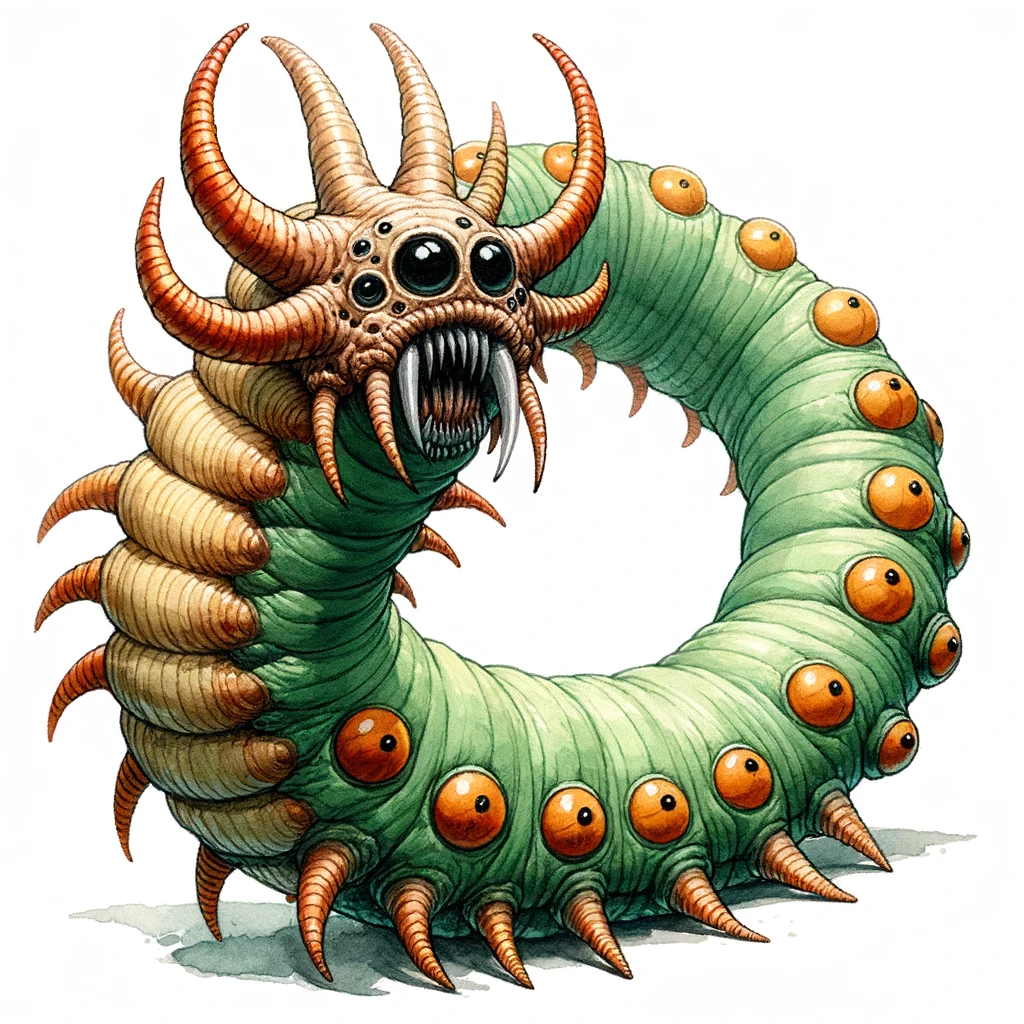5.9176 Pentranomeker Worm
| CLIMATE/TERRAIN: | Mechanus |
| FREQUENCY: | Uncommon (rare away from portals) |
| ORGANISATION: | Solitary or hextet |
| ACTIVITY CYCLE: | Any |
| DIET: | Material of non-Mechanical origin |
| INTELLIGENCE: | Animal (10) |
| TREASURE: | Nil |
| ALIGNMENT: | Lawful Neutral |
| NO. APPEARING: | 1 or 6 |
| ARMOUR CLASS: | 6 |
| MOVEMENT: | 12 |
| HIT DICE: | 8 |
| THAC0: | 16 |
| NO. OF ATTACKS: | 1 |
| DAMAGE/ATTACK: | 1d8 |
| SPECIAL ATTACKS: | Nil |
| SPECIAL DEFENCES: | Hextet circle defence |
| MAGIC RESISTANCE: | Nil |
| SIZE: | Huge (25.594 feet) |
| MORALE: | Steady (11-12) |
| XP VALUE: | 650 |
Many have wondered why a unit of measurement called a worm (and its subunits called segments) exist in Mechanus. Little do they know that the answer is linked to a bizarre and fascinating creature.
— From Nimal Amur’s A Field Guide to the invertebrates of Mechanus

The 5.9176 pentranomeker worm is a strange creature that dwells only in Mechanus. It’s name is a shortened version of the name the modrons gave it which was, A Large Pseudo-Arthropodal Annelid Of Approximately 5.9176 Pentronomekers In Length, Weighing Approximately 2 Tons at Maximum Weight, Which Feeds Upon Non-native Non-living Material.
This creature resembles a giant inch worm with a body divided into exactly 20 even lengths segments. Its soft exoskeleton is largely green in colouration with amber disks. It has a snout similar to that of a star nosed mole surrounded by a circlet of black eyes. Its mouth is a sticky disk is located on the underside of the head segment. The tail segment is encased with metal and used for defence.
COMBAT: When threatened a pentranomeker worm lifts up its tail segment threateningly and uses it to club his enemies. If a group of six (a hextet) of worms is threatened they form a circle with their heads facing the middle and all raise their tail segments, if the threats do not cease they send their tails crashing down on the unfortunate soul.
HABITAT/SOCIETY: Most of these worms are domesticated creatures used as mounts (they travel at the average human walking speed yet never seem to tire), measuring devices, and clean up crews.
Wild pentronomeker worms (like the domestic ones) are solitary unless six meet up, then they travel in a hextet until one dies and they go their separate way or division makes the group have more than six members. Wild worms migrate from portal to portal feeding upon non-living material brought into Mechanus such as dirt. The non-living material sticks to the worms feeding pad and is absorbed by diffusion. An amazing thing about these worms is that the amber coloured disks on their skin contain small lines of different colours, these lines recorded how far and how long these worms travelled in a straight line, thus the worms have a built in record of their migration routes. Since these worms usually travel in straight lines most of their movements have been recorded by fastidious Guvner zoologists and the like.
Pentronomeker worms reproduce by division. One worm splits along the middle from front to back into two evenly long worms.
ECOLOGY: These worms have a vital function of keeping the metal disks of Mechanus clean by eating foreign material. Oddly enough they cannot survive outside Mechanus.
Source: Joshua Jarvis


